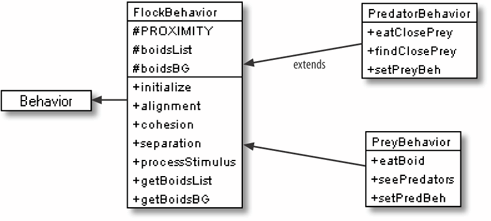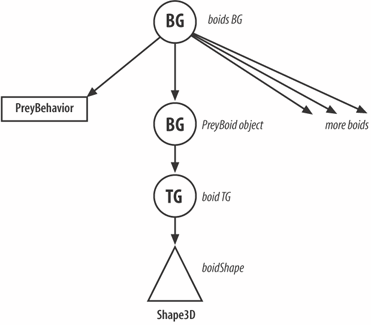Class Diagrams for Shooter3D
Flock BehaviorThe public and protected methods and data of the FlockBehavior class and its PredatorBehavior and PreyBehavior subclasses are shown in Figure 22-7. Figure 22-7. FlockBehavior and its subclasses FlockBehavior has two main tasks:
FlockBehavior doesn't create boids since that's handled by its subclasses, and the information required for each type of boid is too specialized to be located in the superclass. PredatorBehavior creates a series of PredatorBoids, and PreyBehavior handles PreyBoids. But the subclass behaviors do use the inherited boidsList list for storage. Animate the BoidsThe calls to animateBoid( ) are carried out in processStimulus( ): public void processStimulus(Enumeration en) { Boid b; int i = 0; while((b = boidsList.getBoid(i)) != null) { b.animateBoid( ); i++; } wakeupOn(timeOut); // schedule next update } Velocity Rules AgainFlockBehavior is a general-purpose flock manager, so it stores the basic velocity methods used by all boids: Reynolds' cohesion, separation, and alignment rules. All the rules have a similar implementation since they examine nearby flockmates and build an aggregate result. This is converted into a velocity and scaled before being returned. As explained at the start of this chapter, Reynolds' notion of flockmates is based on a distance measure and an angle around the forward direction of the boid. However, the rules in Flocking3D only utilize the distance value, effectively including flockmates from all around the boid. The angle measure is dropped because of the overhead of calculating it and because the behavior of the boids seems realistic enough without it. A boid using an angle component is only influenced by the boids within its field of vision. The general effect is that a flock is more affected by changes to boids near the front and less affected by changes toward the back. The cohesion( ) method is shown below. It calculates a velocity that encourages the boid to fly toward the average position of its flockmates: public Vector3f cohesion(Vector3f boidPos) { avgPosn.set(0,0,0); // the default answer int numFlockMates = 0; Vector3f pos; Boid b; int i = 0; while((b = boidsList.getBoid(i)) != null) { distFrom.set(boidPos); pos = b.getBoidPos( ); distFrom.sub(pos); if(distFrom.length( ) < PROXIMITY) { // is boid a flockmate? avgPosn.add(pos); // add position to tally numFlockMates++; } i++; } avgPosn.sub(boidPos); // don't include the boid itself numFlockMates--; if(numFlockMates > 0) { // there were flockmates avgPosn.scale(1.0f/numFlockMates); // calculate avg position // calculate a small step towards the avg. posn avgPosn.sub(boidPos); avgPosn.scale(COHESION_WEIGHT); } return avgPosn; } avgPosn and distPosn are global Vector3f objects to reduce the creation of temporary objects when the method is repeatedly executed. The while loop uses getBoid( ) to iterate through the boids list. The loop's complexity is O(n), where n is the number of boids. Since the method is called for every boid, checking the entire flock for cohesion is O(n2). If there are m velocity rules, then each update of the flock will have a complexity of O(m*n2). This is less than ideal and one reason why flocking systems tend to have few boids. A well-designed boids list data structure will reduce the overhead of the calculations; for example, one simple optimization is to utilize boid position in the list's ordering. A search algorithm using spatial information should find a nearby boid in constant time (O(1)), reducing the cost of a flock update to O(m*n). For example, if there are 1,000 boids and 10 rules, then the current algorithm takes time proportional to O(107), whereas the improved version would be O(104), potentially a 1,000-fold improvement In cohesion( ), nearness is calculated by finding the absolute distance between the boid (boidPos) and each neigboring boid. The PROXIMITY constant can be adjusted to change the number of neighbors. The choice of scaling factor (COHESION_WEIGHT in this case) is a matter of trial and error, determined by running the system with various values and observing the behavior of the flock. Part of the difficulty when deciding on a good value is that the rules interact with each other to produce an overall effect. For example, the cohesion rule brings boids together while the separation rules keep them apart. This interplay is what makes boid behavior hard to predict and so interesting. The Prey's BehaviorPreyBehavior has three tasks:
Boid creation is done in createBoids( ), called from the class's constructor: private void createBoids(int numBoids, Obstacles obs) { // preyBoids can be detached from the scene boidsBG.setCapability(BranchGroup.ALLOW_CHILDREN_WRITE); boidsBG.setCapability(BranchGroup.ALLOW_CHILDREN_EXTEND); PreyBoid pb; for(int i=0; i < numBoids; i++){ pb = new PreyBoid(obs, this); boidsBG.addChild(pb); // add to BranchGroup boidsList.add(pb); // add to BoidsList } boidsBG.addChild(this); // store the prey behavior with its BG } boidsBG is the inherited BranchGroup holding the boids in the scene; boidsBG's capabilities must allow changes to its children so prey boids can be detached from it at run-time (after they're eaten). When a PreyBoid object is created, it's passed a reference to the obstacles (passed to the behavior from WrapFlocking3D) and a reference to the behavior itself, so its velocity rules can be accessed. createBoid( ) creates a scene branch such as that shown in Figure 22-8. Figure 22-8. Scene branch for PreyBoid nodes Velocity Rules and Other FlocksPreyBehavior's second task is complicated by the need to access the other flock (the predators), which means that it must reference the PredatorBehavior object. WrapFlocking3D delivers the reference via PreyBehavior's setPredBeh( ): public void setPredBeh(PredatorBehavior pb) { predBeh = pb; }
seePredators( ) is coded in a similar way to the rules in FlockBehavior: a loop tests each of the boids in the predator flock for proximity. If a predator is within range, the velocity will be set to a scaled move in the opposite direction: public Vector3f seePredators(Vector3f boidPos) { predsList = predBeh.getBoidsList( ); // refer to pred list avoidPred.set(0,0,0); // reset Vector3f predPos; PredatorBoid b; int i = 0; while((b = (PredatorBoid)predsList.getBoid(i)) != null) { distFrom.set(boidPos); predPos = b.getBoidPos( ); distFrom.sub(predPos); if(distFrom.length( ) < PROXIMITY) { // is pred boid close? avoidPred.set(distFrom); avoidPred.scale(FLEE_WEIGHT); // scaled run away break; } i++; } return avoidPred; } // end of seePredators( ) An important difference in this code from earlier rules is the first line, where a reference to the predators list is obtained by calling getBoidsList( ) in PredatorBehavior. The prey examine this list to decide if they should start running. Goodbye PreyPreyBehavior contains an eatBoid( ) method, called by PredatorBehavior when the given boid has been eaten: public void eatBoid(int i) { ((PreyBoid)boidsList.getBoid(i)).boidDetach( ); boidsList.removeBoid(i); } eatBoid( ) deletes a boid by detaching it from the scene graph, and removing it from the boids list. The Predator's BehaviorPredatorBehavior has similar tasks to PreyBehavior:
Boid creation is almost identical to that done in PreyBehavior, except that PredatorBoids are created instead of PreyBoids. PredatorBoid has a method, setPredBeh( ), which allows WrapFlocking3D to pass it a reference to the PreyBehavior object. The velocity rule is implemented by findClosePrey( ): the method calculates the average position of all the nearby PreyBoids and moves the predator a small step toward that position. The code is similar to other rules, except that it starts by obtaining a reference to the prey list by calling getBoidsList( ) in PreyBehavior. preyList = preyBeh.getBoidsList( ); // get prey list int i = 0; while((b = (PreyBoid)preyList.getBoid(i)) != null) { pos = b.getBoidPos( ); // get prey boid position // use pos to adjust the predator's velocity } Lunch TimeThe third task for PredatorBehavioreating nearby preyisn't a velocity rule but a method called at the start of each predator's update in animateBoid( ). However, the coding is similar to the velocity rulesit iterates through the prey boids checking for those near enough to eat: public int eatClosePrey(Vector3f boidPos) { preyList = preyBeh.getBoidsList( ); int numPrey = preyList.size( ); int numEaten = 0; PreyBoid b; int i = 0; while((b = (PreyBoid)preyList.getBoid(i)) != null) { distFrom.set(boidPos); distFrom.sub( b.getBoidPos( ) ); if(distFrom.length( ) < PROXIMITY/3.0) { // boid v.close to prey preyBeh.eatBoid(i); // found prey, so eat it numPrey--; numEaten++; System.out.println("numPrey: " + numPrey); } else i++; } return numEaten; } // end of eatClosePrey( ) The reference to PreyBehavior is used to get a link to the prey list and to call eatBoid( ) to remove the ith boid. When a boid is removed, the next boid in the list becomes the new ith boid, so the i index mustn't be incremented. |
EAN: 2147483647
Pages: 340
